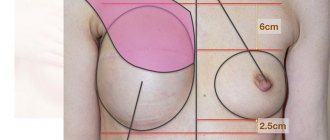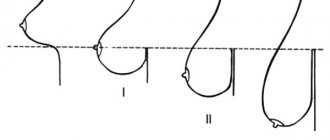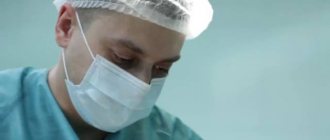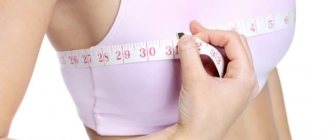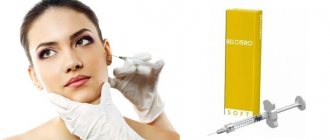Modern computer programs allow you to simulate a future bust.
The doctor collects anamnesis. This is a very important stage; the specialist must tell you whether you have had breast surgery in the past, what medications you are currently taking, and whether you have any allergies to medications. Next, the surgeon determines the date of the operation and sends the patient for preoperative examination.
What tests will be required before mammoplasty?
Before the operation, the patient must undergo a complete medical examination to identify general health and possible contraindications. The list of standard preoperative studies includes:
- General blood analysis.
- Biochemical blood test (total protein, ALT, AST, total bilirubin, creatinine, urea, glucose, electrolytes).
- General urine analysis.
- Analysis for blood group and Rh factor.
- Blood test for HIV, syphilis and hepatitis B and C (HBsAg, HCV).
- Blood test for coagulogram (blood clotting).
- Analysis for class E immunoglobulins to identify predisposition to allergic reactions in order to correctly select anesthesia.
- Analysis of hormonal levels to prevent implant rejection.
- ECG.
- Fluorography.
- Ultrasound of the mammary glands.
The therapist gives a conclusion about readiness for surgery. To prepare for anesthesia, you will need to visit an anesthesiologist.
If the surgeon doubts the condition of the mammary glands, the patient is sent for a consultation with a mammologist to examine the breasts for mastopathy, cysts, oncology and other pathological conditions that require preliminary treatment. The doctor may prescribe additional diagnostic procedures, such as mammography.
Breast reconstruction methods:
- Installation of permanent implants. Modern silicone prostheses have a variety of sizes, shapes, and are made of plastic materials compatible with breast tissue. This allows you to select the most suitable implant, allowing you to recreate symmetry. Sometimes a healthy breast lift is necessary for optimal results.
- Using an expander (tissue expander). Necessary for a two-stage operation to form a pocket capable of accommodating a permanent implant. It is a balloon located under the pectoralis major muscle, into which saline solution is gradually introduced (from 20-40 ml to 250-350), as a result of which the skin and muscle are stretched to the required size.
- Microsurgical operations using your own tissue flaps are the most modern technologies for achieving long-term aesthetic and functional results. They require high professionalism of the plastic surgeon and the entire operating team, high-precision equipment and the ability to work with it.
- TRAM flap – breast reconstruction by transplanting a musculocutaneous flap from the abdominal area while maintaining the blood supply. Suitable for patients with thin skin, those who cannot install implants, or those who are overweight or obese.
- DIEP flap is a more complex method; a skin-fat flap from the lower abdomen is used for transplantation. In this case, the muscles are not affected, the abdominal wall is preserved, so the rehabilitation period is faster, the restored breast has a more natural shape, and an additional advantage is the ability to improve the contours of the figure.
The choice of reconstruction method depends on the condition of the breast tissue after mastectomy, the presence and nature of the scar, the preservation of the fold under the breast, the patient’s physique and concomitant diseases, the need for plastic surgery of a healthy breast, contraindications and other factors. The decision is made by the surgeon together with the patient after discussing possible techniques and results of the intervention.
The price of reconstructive surgery also depends on the chosen method and the need for intervention on a healthy mammary gland.
Prohibitions before surgery
- A month before surgery, you need to stop taking certain medications and even vitamin-mineral complexes. Some of them have a bad effect on healing and scarring. This is especially true for dietary supplements with vitamin E.
- For 2 weeks you need to stop taking glucocorticosteroids and oral contraceptives.
- For two weeks, drugs that reduce blood clotting, such as Aspirin, are eliminated.
- It is necessary to exclude non-steroidal anti-inflammatory drugs (Ibuprofen, etc.), because they affect the speed of blood flow and the walls of blood vessels.
- Be sure to eliminate alcohol and smoking for 1 month.
Prices
Prices for reconstructive mammoplasty in Moscow depend on the chosen method, the complexity of the operation and the need for intervention on a healthy mammary gland, as well as the experience and qualifications of the plastic surgeon.
The cost of an operation with plastic surgeon Rano Azimova ranges from 200,000 to 400,000 rubles. The final cost of the operation is determined after a face-to-face consultation with a doctor.
| Sign up for a free consultation with a doctor. Leave a request on the website, we will contact you shortly | Registration online |
Recommendations after mammoplasty
What to expect the first time after surgery?
On the first day, a drainage will be installed in the chest, which drains serous-hemorrhagic fluid. Compression garments are placed on the bust and will need to be worn for two months. It records the result. During this period, the breasts are swollen, hard to the touch, and unusually high. Bruising may occur. The pain syndrome is relieved with special drugs that are administered intravenously while the patient is in the hospital.
In the early postoperative period, it is prohibited to raise your arms above your shoulders, as well as objects weighing more than 5 kg. It is necessary to avoid sudden movements and do not open doors yourself.
How is the rehabilitation going?
The patient is in the hospital for 1-2 days; bed rest is indicated on the first day. At home, you should continue to take the antibiotics prescribed by your doctor and wash your sutures. You should definitely wear compression garments; they fix the new shape of your breasts. In the first 3-5 days, discomfort and pain are possible, so the doctor prescribes a painkiller.
On days 10-12, the stitches are removed, but it is too early to evaluate the result, because bruises and swelling persist. In the first two weeks, you should not play sports, take a hot shower or bath, or lift weights.
Full recovery occurs after 6 months, during which time all restrictions are gradually lifted.
General recommendations after breast surgery
- Give up sports for 6 months. Some sports cannot be resumed forever.
- Avoid baths and saunas for 2 months. In the future, ensure that the temperature in the steam room does not exceed +100 C.
- Plan pregnancy at least 6 months after surgery.
- Driving is not recommended because it puts stress on the pectoral muscles. Also, do not squeeze your bust with a seat belt.
- In the first 2-3 weeks you need to sleep on your back.
- Avoid intimacy for a month.
- Avoid intense tanning and solariums for 6-12 months.
- Avoid hot baths for 6-8 weeks.
- Do not swim in the sea or pool for 2-3 months.
- Do not smoke or drink alcohol for 2-4 weeks.
What type of mammoplasty is right for you?
Often girls who come to me for consultations have very vague ideas about what kind of breasts they want. Many people come with the request “I want breasts like ....”, or strive for some other standards that were imposed on them from the outside or that endlessly flash before their eyes in modern media. Therefore, the first thing we do with my patients during consultation is to form adequate ideas about what kind of breast this particular patient needs, and what kind of surgery she requires.
The main types of mammoplasty have already been described in the corresponding section of the site, and today I will not dwell on them in detail. Today I would like to dwell on such an aspect as the individual characteristics of girls , and the choice of the ideal breast for each specific case.
Let's start with the fact that there is a certain generally accepted aesthetic ideal of beautiful breasts . According to him, the breasts should be “erect”, elastic, regularly rounded, with smooth skin, symmetrical, not necessarily large, and most importantly, in harmony with your build. That is, for very thin girls, I would not recommend enlarging their breasts to size 3 or larger, because... Not only does it not look very harmonious, but it also puts an inadequate load on the spine and back muscles, which can lead to health problems.
During the consultation, I make sure to tell the patient about what problems await her if we perform exactly the kind of operation that she initially wants, but the clinical situation does not allow this. In this case, fulfilling the patient’s wishes will entail certain health and aesthetic problems.
Enlargement, reduction or tightening?
This choice is most often faced by girls who have given birth and breastfed, or girls who have lost a lot of weight. In both cases, their breasts lost their original shape and decreased in size. Many people think that this can only be corrected by installing implants, but this is not always the case. In some cases, only a breast lift is required, namely in cases where the amount of fat and glandular tissue remains the same as before childbirth (or weight loss). In these cases, you can bring the breasts to an aesthetic appearance by removing part of the stretched skin, and thereby lifting the breasts.
However, there are also cases when installing implants would not be superfluous: if, for example, the patient wants slightly larger breasts than she had before giving birth/weight loss. Then you can combine augmentation mammoplasty (installation of implants) with mastopexy (breast lift).
I also quite often combine breast reduction and lift - in case the breasts are disproportionately large and heavy - they often sag, losing their shape. Excision of excess fat, glandular and skin tissue makes it possible to reduce the size of the breasts, and with the help of a lift, the breasts are lifted and as a result of the operation we have symmetrical breasts, proportional to the girl’s figure.
In the case of breast asymmetry (when one breast is larger than the other, or the areolas are located at different heights), there are several solutions, and the choice of solution depends on the characteristics of the individual patient. Either we do a lift with excision of excess tissue - if the breasts are larger than the patient would like; or we do breast replacement with implants of different volumes. Thus, we bring the breasts to the same size and correct the asymmetry of the areolas, if necessary, surgically.
Combination of mammoplasty methods
Since each breast, like each of my patients, is unique, I quite often resort to a combination of different types of mammoplasty . And in most cases, the decision to choose methods for obtaining the desired result is made only during a personal consultation, examination and conversation with the patient.
Mammoplasty, the work of Dr. A.P. Panayetov:
Breast augmentation:
Breast lift:
Mammoplasty, prices:
- Breast augmentation - 120,000 rub.
- The cost of implants depends on the company and shape, and ranges from 45,000 rubles to 83,200 rubles.
Breast lift or reduction:
- I degree of sagging (when the nipple is at the level of the subglandular fold) - 150,000 rub.
- II degree of sagging (when the nipple is below the subglandular fold to approximately 3 cm, but it is above the lower edge of the gland) - 120,000 rub.
- III degree of sagging (when the nipple looks down and is on the edge of the gland) - 230,000 rub.
Accompanying services:
- Consultation - 1,000 rub.
- The cost of anesthesia is determined on the day of consultation and depends on the volume of the operation.
If you have any questions, you can ask me on social networks. You can make an appointment for a consultation in Moscow by calling +7 (viber, whatsapp) or using the feedback form on the website:
Contraindications to breast surgery
Pathologies in which surgical intervention is highly likely to lead to deterioration of health or dangerous complications for the patient are contraindications for mammoplasty.
These include:
- Severe chronic somatic diseases.
- Pathologies of the endocrine system in the stage of decompensation: diabetes mellitus, hyper- and hypothyroidism.
- Oncological diseases.
- Systemic blood coagulation disorders.
- Acute infectious and inflammatory processes.
- Eczematous or pustular lesions of the skin in the area of surgical intervention.
- Mental illnesses characterized by inappropriate behavior.
- Age up to 18 years.
- Period of pregnancy, lactation.
How is the operation performed?
Any procedure for breast correction is performed under general anesthesia. The patient is in deep, medicated sleep throughout the entire operation.
Plastic surgery lasts 2-3 hours depending on the complexity. Immediately on the surgical table, the patient is put on compression garments, which she wears for 1 month.
After the operation, you need to spend a day or two in the hospital under the supervision of specialists.
WE ALSO ADVISE YOU TO READ: Possible complications after breast augmentation
Indications for mammoplasty
Often a woman undergoes breast surgery not for medical reasons, but in order to give her breasts a perfect shape.
- Micromastia is underdevelopment of the mammary glands.
- Large breast volume, causing physical or psychological discomfort in the patient.
- Asymmetrical arrangement of glands.
- Descent (ptosis) of the mammary glands after childbirth, or due to age.
- Defects of nipples and areolas.
- Pronounced atrophic changes in the gland (stretching, sagging) after the lactation period.
- Condition after mastectomy.
Examination before breast plastic surgery
According to the standards of leading European clinics involved in breast aesthetics, all patients (planning to undergo plastic surgery on the breast) are recommended to undergo mammography or MRI diagnostics (after 30 years) or ultrasound of the mammary glands (before 30 years). This allows us to avoid cases of undiagnosed breast pathology, which we can remove along with plastic surgery.
We recommend completing these surveys HERE.
If any problems are detected, our specialists will eliminate them during plastic surgery.
You can consult our plastic surgeons about the results of these examinations.
Plastic surgery breast
When you have finally made a decision about your operation and have agreed on its details with your doctor, you will need to make an appointment for hospitalization at the University Breast Center by phone or.
Having confirmed the date of hospitalization, perform the necessary examinations according to the list given to you by our doctor during consultation. See the indicative list of examinations HERE.
On the day approved by telephone, you must appear at the University Breast Center by 9:00 for hospitalization, paperwork and signing your consent to the operation.
FAQ
Is it possible to install an implant for breast fibroadenoma?
Yes, it is possible to install implants for fibroadenoma.
Does mammoplasty have age restrictions?
The operation can be performed after 18 years of age and thereafter at any age, if there are no contraindications, as long as the body is able to tolerate anesthesia.
Is anesthesia dangerous?
The effect of anesthesia is not dangerous. Previously, the anesthesiologist collects anamnesis to find out the predisposition to possible complications and exclude them.
Will plastic surgery lead to an increase in stretch marks on the chest?
Placing an implant may cause stretch marks on the breasts. This happens extremely rarely if the breast size needs to be significantly increased.
Does surgery increase the risk of cancer?
It has been proven that breast enlargement does not affect the occurrence of tumors of either a benign or malignant nature.
Increasing body weight negatively affects the results - is this true?
Extra pounds are distributed throughout the body, including the chest area. If body weight has increased significantly, this will also be reflected in the increase in centimeters in the bust.
At what age is it better to have mammoplasty?
The optimal age for implant placement is 18 years or older. The main thing is that the woman has no contraindications.



